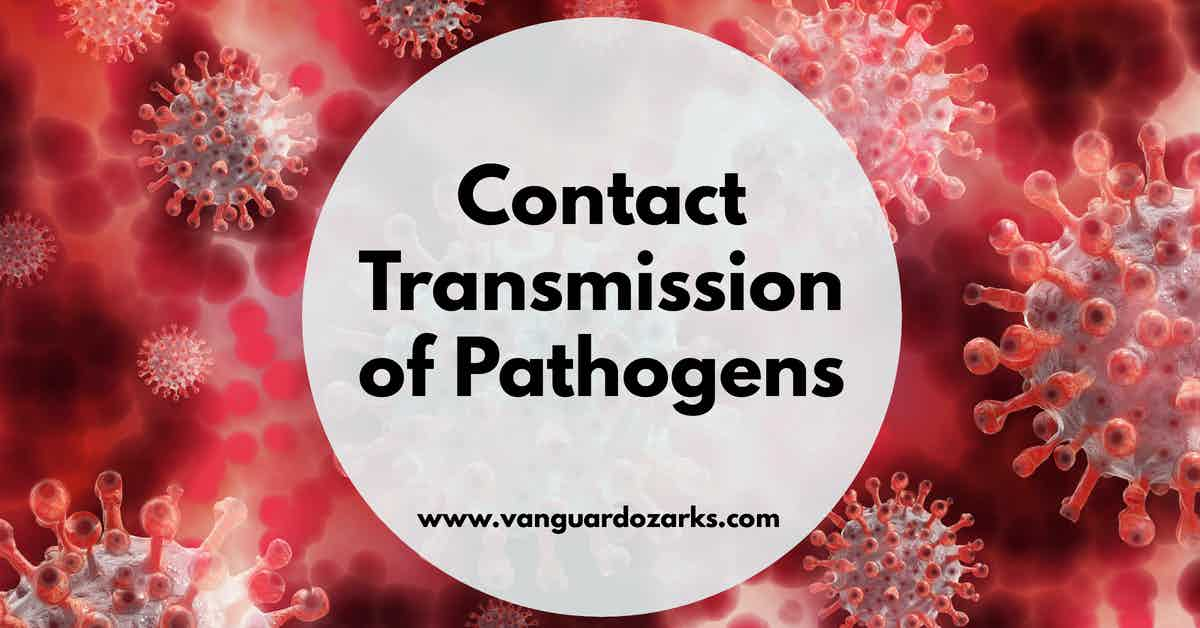The transmission of pathogens via contact with contaminated surfaces or individuals is the most common route for the spread of germs and viruses, underscoring the importance of high-performance facility hygiene programs focused on cleaning for health.

Contact Transmission of Pathogens and Diseases in Public Facilities
Contact transmission of germs and viruses is the most prevalent route of infection in humans.
This is true with both airborne respiratory viruses, such as:
- Coronaviruses.
- Influenza.
- Measles, and;
- Rhinovirus;
And enteric or gut-related pathogens, such as:
- Norovirus.
- Rotavirus, and;
- Hepatitis A.
The germs are spread through either direct physical contact with an infected person or indirectly via contact with a contaminated surface or vector, such as a mosquito.
According to Deleware Health and Social Services;
Direct contact infections spread when disease-causing microorganisms pass from the infected person to the healthy person via direct physical contact with blood or body fluids.
Examples of direct contact are touching, kissing, sexual contact, contact with oral secretions, or contact with body lesions.
Indirect contact infections spread when an infected person sneezes or coughs, sending infectious droplets into the air.
If healthy people inhale the infectious droplets, or if the contaminated droplets land directly in their eyes, nose, or mouth, they risk becoming ill.
Droplets generally travel between three and six feet and land on surfaces or objects including tables, doorknobs, and telephones.
Healthy people touch the contaminated objects with their hands and then touch their eyes, nose, or mouth.
Surface Contamination & Pathogen Transmission
Surfaces function as reservoirs for pathogens expelled from the body via:
- Coughing or sneezing.
- Talking.
- Vomiting, and;
- Touch.
Depending on the environment, surface, and type of virus, pathogens can survive in an infectious state outside of the body for several hours, often days, and sometimes for weeks if left undisturbed.
Intrinsic factors, like fomite properties, virus strain, and viral inoculation titer, consistently impact the total virus survival end point (hours, days).
The majority of viruses remain viable longer on nonporous surfaces; however, there are exceptions.
Astrovirus survives for 90 days on porous paper but only 60 days on nonporous aluminum.
Typically, nonenveloped enteric viruses remain viable longer on surfaces than enveloped respiratory viruses.
The enteric viruses HAV, astrovirus, and rotavirus can all remain infective on surfaces for 2 months or longer.
In contrast, respiratory viruses usually remain viable for several hours to several days.
Significance of Fomites in the Spread of Respiratory and Enteric Viral Disease
Numerous studies have demonstrated the rapidity with which pathogens can spread throughout a facility, contaminating both surfaces and occupants in a matter of hours.
One of the most commonly cited sources for spreading infectious disease between surfaces and occupants in a public facility is door handles, especially the handle on the front or main entrance.
According to the results of a study published in The Journal of Hospital Infection;
About 107pfu were applied to exposed contact points such as door handles or the hands of volunteers.
After touching of these handles and common social contacts like handshaking, re-isolation rates were determined from the hands of our test persons.
Contaminated door handles and skin surfaces were found to be efficient sources for potential infection.
At least 14 persons could be contaminated by horizontal spread, one after the other by touching the same door handle.
Successive transmission from one person to another could be followed up to the sixth contact person.
These results were confirmed under everyday life conditions in a flat shared by four students.
The transmission could not be prevented by the usual standards of hand hygiene [...]
Disrupting Pathogen Transmission Through Surface Cleaning and Decontamination
Three key factors determine a pathogen's ability to infect a person and make them ill:
- Infective dose or viral load.
- Virulence--how deadly the disease is, and;
- The state of an individual's immune system.
Reducing the infective dose found on surfaces through cleaning and disinfection reduces the chances of infection spreading to facility occupants.
In facilities that typically house occupants with compromised, underdeveloped, or inhibited immune systems, such as:
- Hospitals and doctor's offices.
- Daycares and elementary schools, and;
- Long-term care or retirement facilities; or;
- During outbreaks;
Increased cleaning frequency and targeted fomite disinfection will reduce the viral load located on surface reservoirs to a level unlikely to present a danger to occupants.
Increased cleaning and targeted disinfection services are especially vital in emergency rooms and surgery centers where patients are commonly exposed to pathogenic bacteria with especially high virulence levels--often referred to as antibiotic-resistant superbugs, such as MRSA.
Over the past decade, there is excellent evidence in the scientific literature that contaminated environmental surfaces and non-critical patient care items play an important role in the transmission of several key healthcare-associated pathogens including methicillin-resistant Staphylococcus aureus, vancomycin-resistant enterococci, Acinetobacter, norovirus, and Clostridium difficile.
Thus, surface disinfection of noncritical environmental surfaces and medical devices is one of the infection prevention strategies to prevent pathogen transmission.
References & Resources
Takeaway
A clean for health regimen focused on using state-of-the-art and scientifically-backed cleaning appliances and products, combined with targeted fomite disinfection and routine occupant hand hygiene programs, is a proven method for disrupting the chain of infection and preventing the spread of disease.
Outsourcing your facilities' cleaning and infection prevention and control program to an experienced provider is an effective method for rapidly onboarding necessary skillsets and labor resources with the combined equipment and expertise required to systematically eliminate surface-resident pathogens and pathogenic bacteria from your facility at a fraction of the cost of maintaining a similar service, in-house.
Contact us today and discover why Vanguard Cleaning Systems® is the Standard of Clean® for businesses throughout Northwest Arkansas, Missouri, and Oklahoma.
In Oklahoma, dial 918-960-4450
In Arkansas, dial 479-717-2410
In Missouri, dial 417-812-9777

